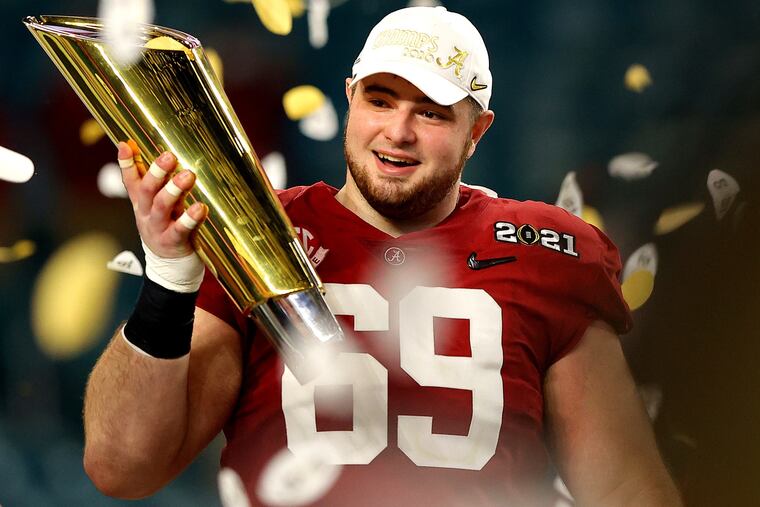The Eagles have science on their side, so drafting oft-injured Landon Dickerson was brilliant | Marcus Hayes
Studies show that linemen who return to play do so with a higher risk of injury but with no appreciable decline in productivity. Some even play better.

For better or worse, the Eagles rely on the pocket protector crowd for most of their decisions. Analytics and sports science reign at the NovaCare complex.
And so it was sports science that delivered to Eagles nation Landon Dickerson. He’s the outrageously talented, 6-foot-6, 325-pound center out of Alabama ... with more stitches in his body than Frankenstein’s monster.
He had ACL surgery on his right knee in 2016 after tearing it in practice; right ankle surgery in 2017 after an early-season in-game injury; left ankle surgery in 2018 after an early-season in-game injury; then stayed healthy for 2019 and most of 2020 before he tore his left ACL in the SEC title game Dec. 19.
Without all the anesthesia, Dickerson would have been gone before the second hour of the draft show was over. He’s a monstrous, generational talent, and he cost the Eagles a second-round pick.
Some draftniks consider the second round fertile ground for solid NFL starters. Fine. It can also be a place where you can steal some top-tier players. Maybe a running back or receiver with a little baggage, or a tight end or without a complete NFL game — you know, players like LeSean McCoy, or DeSean Jackson, or Zach Ertz, or Dallas Goedert. Do your homework, and you can beat the field.
The Eagles have done that.
One NFL source and one team source said this week that the Eagles researched the return-to-sports rates for ACL tear victims, and, in particular, how effectively linemen who return to sports play. They crunched the numbers and decided the gamble on Dickerson was a no-brainer. In fact, they’re sure that Dickerson could help the team before November.
Most studies indicate that players require a full year to return to play, though Eagles general manager Howie Roseman said last week, “We’re confident it’s not going to be a redshirt season.”
It’s a bold prediction, though Eagles center Jason Kelce was fully cleared to return for training camp 10 months after tearing his right ACL in 2012.
Kelce then went on to make four Pro Bowls and win three All-Pro awards, all since 2014. That’s right; he got better after his surgery at the age of 24.
Coincidentally, Dickerson was drafted to replace Kelce. But it wasn’t Kelce’s ultra-tough mindset or his unusual athleticism with which the Eagles compare Dickerson.
“This guy’s mentality reminds you of Jon Runyan,” Roseman told WIP-FM on Tuesday. Runyan, the Eagles’ right tackle from 2000-08, was known for his nastiness. So is Dickerson. “He wants to put people into the ground. He wants to bury guys.”
That’s why Roseman couldn’t resist.
“You never have a chance to get a guy like this [in the second round],” he said. “We know it’s a risk, but it’s a risk worth taking.”
The science is promising.
Glass half full?
One study published in June of 2017 found that, from 1980 to 2015, NFL offensive linemen who returned to play after undergoing ACL surgery — 62.6% — suffered no significant decrease in performance or longevity. In other words, if you make it back, you make it all the way back:
“Linemen who ... return to play do so at a high level, with no difference regarding in-game performance or career duration when compared with matched controls.”
Another study published in December of 2019, expressly approved by the NFL, found that, from 2006-2012, about three out of four college players entering the NFL with a repaired ACL didn’t reinjure the joint.
The knee injury rate for players with previous ACL injuries was 26%; 12% reinjured the repaired knee, while 14% injured the other knee. On average, these injuries occurred within the players’ first two seasons. That injury rate was about 17% percentage points than the knee injury rate of players without a previously injured knee, which was 9%.
That means that Dickerson is almost three times more likely to injure one of his knees knee than is, say, Milton Williams, the defensive lineman they drafted in the third round, who has no known knee injury history.
“Conclusion: NFL athletes with a history of successful ACL reconstruction before being drafted into the NFL have a significantly higher rate of subsequent ACL reinjury while playing in the NFL when compared with a carefully matched cohort of players without a history of prior ACL injury.”
Of course, the study did not cite any players who had torn both ACLs, much less needed surgery on both ankles, all before the age of 23.
What they’re saying
Predraft projections for Dickerson were all over the map. One NFL executive told me he and his team agreed that Dickerson should not be considered before the fifth round. However, another said he recommended Dickerson be taken in the early second round and certainly no later than the third. That executive was once affiliated with the Eagles.
Notably, both of those executives were bullish on Sidney Jones in 2017. Jones was a blue-chip cornerback who ruptured his Achilles’ tendon at the University of Washington’s pro day. Projected as a top-15 pick, Jones slid to the second round, where the Eagles picked him 43rd overall. He played in just 22 games for the Eagles, with eight starts, before they released him last year. He was an unmitigated bust.
“Yes,” said one Eagles executive in the spring of 2020, but he insisted, “but the risk was worth it.”
Contacted this spring about Dickerson, the executive said, “A cornerback with an Achilles is a lot different from a lineman with a knee.”
The science, at least, seems to support that.